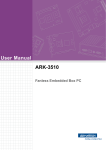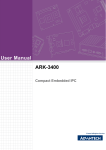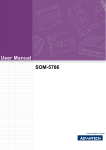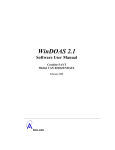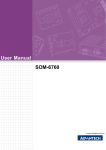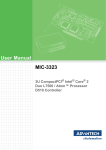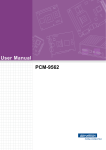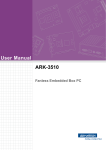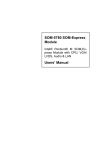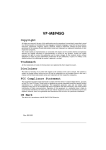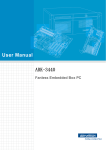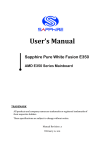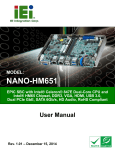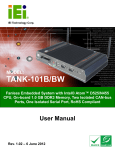Download User Manual ARK-3420
Transcript
User Manual ARK-3420 Compact Embedded IPC Copyright The documentation and the software included with this product are copyrighted 2009 by Advantech Co., Ltd. All rights are reserved. Advantech Co., Ltd. reserves the right to make improvements in the products described in this manual at any time without notice. No part of this manual may be reproduced, copied, translated or transmitted in any form or by any means without the prior written permission of Advantech Co., Ltd. Information provided in this manual is intended to be accurate and reliable. However, Advantech Co., Ltd. assumes no responsibility for its use, nor for any infringements of the rights of third parties, which may result from its use. Acknowledgements Award is a trademark of Award Software International, Inc. VIA is a trademark of VIA Technologies, Inc. IBM, PC/AT, PS/2 and VGA are trademarks of International Business Machines Corporation. Intel® and Pentium® are trademarks of Intel Corporation. Microsoft Windows® is a registered trademark of Microsoft Corp. RTL is a trademark of Realtek Semi-Conductor Co., Ltd. ESS is a trademark of ESS Technology, Inc. UMC is a trademark of United Microelectronics Corporation. SMI is a trademark of Silicon Motion, Inc. Creative is a trademark of Creative Technology LTD. CHRONTEL is a trademark of Chrontel Inc. All other product names or trademarks are properties of their respective owners. For more information about this and other Advantech products, please visit our website at: http://www.advantech.com/ http://www.advantech.com/ePlatform/ For technical support and service, please visit our support website at: http://support.advantech.com.tw/support/ ARK-3420 User Manual Part No. 2006K34200 Edition 1 Printed in China March 2009 ii Product Warranty (2 years) Advantech warrants to you, the original purchaser, that each of its products will be free from defects in materials and workmanship for two years from the date of purchase. This warranty does not apply to any products which have been repaired or altered by persons other than repair personnel authorized by Advantech, or which have been subject to misuse, abuse, accident or improper installation. Advantech assumes no liability under the terms of this warranty as a consequence of such events. Because of Advantech’s high quality-control standards and rigorous testing, most of our customers never need to use our repair service. If an Advantech product is defective, it will be repaired or replaced at no charge during the warranty period. For outof-warranty repairs, you will be billed according to the cost of replacement materials, service time and freight. Please consult your dealer for more details. If you think you have a defective product, follow these steps: 1. Collect all the information about the problem encountered. (For example, CPU speed, Advantech products used, other hardware and software used, etc.) Note anything abnormal and list any onscreen messages you get when the problem occurs. 2. Call your dealer and describe the problem. Please have your manual, product, and any helpful information readily available. 3. If your product is diagnosed as defective, obtain an RMA (return merchandize authorization) number from your dealer. This allows us to process your return more quickly. 4. Carefully pack the defective product, a fully-completed Repair and Replacement Order Card and a photocopy proof of purchase date (such as your sales receipt) in a shippable container. A product returned without proof of the purchase date is not eligible for warranty service. 5. Write the RMA number visibly on the outside of the package and ship it prepaid to your dealer. Declaration of Conformity FCC Class A Note: This equipment has been tested and found to comply with the limits for a Class A digital device, pursuant to part 15 of the FCC Rules. These limits are designed to provide reasonable protection against harmful interference when the equipment is operated in a commercial environment. This equipment generates, uses, and can radiate radio frequency energy and, if not installed and used in accordance with the instruction manual, may cause harmful interference to radio communications. Operation of this equipment in a residential area is likely to cause harmful interference in which case the user will be required to correct the interference at his own expense. iii ARK-3420 User Manual Technical Support and Assistance 1. 2. Visit the Advantech web site at www.advantech.com/support where you can find the latest information about the product. Contact your distributor, sales representative, or Advantech's customer service center for technical support if you need additional assistance. Please have the following information ready before you call: – Product name and serial number – Description of your peripheral attachments – Description of your software (operating system, version, application software, etc.) – A complete description of the problem – The exact wording of any error messages Packing List Before installation, please ensure the following items have been shipped: ! 1 x ARK-3420 Unit ! 1 x DVI to CRT adapter connector ! 2 x Desk/Wall mount plate ! 1 x 4-pin Phoenix DC power connector ! 1 x Utility CD ! 1 x Registration and 2 years Warranty card Ordering information Model Number Description ARK-3420F-S6A1E Intel® Core® 2 Duo L7500 1.6GHz Compact Embedded Box IPC ARK-3420F-S1A1E Intel® Core® 2 Duo U7500 1.06GHz Compact Embedded Box IPC ARK-3420F-U0A1E Mobile Intel® Celeron® 550 2.0GHz Compact Embedded Box IPC Optional accessories Part Number Description 1757002161 AC-to-DC Adapter, DC19 V/7.89A 150W, with Phoenix Power Plug, 0 ~ 40° C for Home and Office Use 1702002600 Power cable 3-pin 180 cm, USA type 1700004713 Cable DVI-I to DVI and CRT 1700009398 LVDS cable for ARK-3420 1700009396 LVDS power cable for ARK-3420 1700009399 Digital IO cable for ARK-3420 1700009397 LPT cable for ARK-3420 *9696R00100E 2 slots riser card, 2 x PCIex4 *9696R00200E 2 slots riser card, 2 x PCIex1 *9696R00400E 2 slots riser card, 1 x PCIex4 + 1 x PCI *9696R00500E 2 slots riser card, 1 x PCIex1 + 1 x PCI Note: * By project option. ARK-3420 User Manual iv Contents Chapter 1 General Introduction ...........................1 1.1 1.2 Introduction ............................................................................................... 2 Product Feature ........................................................................................ 2 1.2.1 General ......................................................................................... 2 1.2.2 Display .......................................................................................... 2 1.2.3 Power consumption ...................................................................... 2 Hardware Specification ............................................................................. 3 Mechanical Specification........................................................................... 4 1.4.1 Dimensions ................................................................................... 4 Figure 1.1 ARK-3420 Mechanical Dimension Drawing................ 4 1.4.2 Weight........................................................................................... 4 Power requirement.................................................................................... 4 1.5.1 System power ............................................................................... 4 1.5.2 RTC battery................................................................................... 4 Environmental Specifications .................................................................... 5 1.6.1 Operation temperature.................................................................. 5 1.6.2 Relative Humidity .......................................................................... 5 1.6.3 Storage temperature ..................................................................... 5 1.6.4 Vibration loading during operation ................................................ 5 1.6.5 Shock during operation ................................................................. 5 1.6.6 Safety............................................................................................ 5 1.6.7 EMC .............................................................................................. 5 1.3 1.4 1.5 1.6 Chapter 2 Hardware installation ..........................7 2.1 ARK-3420 I/O Indication ........................................................................... 8 Figure 2.1 ARK-3420 Front View................................................. 8 Figure 2.2 ARK-3420 Rear View ................................................. 8 ARK-3420 front side external I/O connectors............................................ 9 2.2.1 Power ON/OFF Button.................................................................. 9 Figure 2.3 Power ON/OFF Button ............................................... 9 2.2.2 Reset Button ................................................................................. 9 Figure 2.4 Reset Button............................................................... 9 2.2.3 LED Indicators .............................................................................. 9 Figure 2.5 LED Indicators ............................................................ 9 2.2.4 Audio Connector ........................................................................... 9 Figure 2.6 Audio jack connectors ................................................ 9 2.2.5 COM Connector .......................................................................... 10 Figure 2.7 COM port connector ................................................. 10 Table 2.1: COM standard serial port pin assignments .............. 10 2.2.6 eSATA Connector ....................................................................... 10 Figure 2.8 eSATA connector ..................................................... 10 2.2.7 USB Connector ........................................................................... 11 Figure 2.9 USB connector ......................................................... 11 Table 2.2: USB Connector......................................................... 11 2.2.8 Compact Flash Card ................................................................... 11 ARK-3420 rear side external I/O connectors .......................................... 11 2.3.1 Power Input Connector ............................................................... 11 Figure 2.10Power Input Connector............................................. 11 Table 2.3: Power connector pin assignments............................ 11 2.3.2 Digital Visual Interface Connector (DVI-I) ................................... 12 Figure 2.11DVI-I connector......................................................... 12 Table 2.4: DVI-I Connector pin assignments............................. 12 2.3.3 Ethernet Connector (LAN) .......................................................... 13 2.2 2.3 v ARK-3420 User Manual 2.4 2.5 2.6 2.7 2.8 2.9 2.10 Chapter Chapter Figure 2.12Ethernet connector ................................................... 13 Table 2.5: RJ-45 Connector pin assignments ........................... 13 Memory Installation................................................................................. 14 Figure 2.13Memory Installation .................................................. 14 Compact Flash installation...................................................................... 15 Figure 2.14CF Card installation.................................................. 15 HDD installation ...................................................................................... 15 2.6.1 Internal fixed HDD installation .................................................... 15 Figure 2.15Internal Fixed HDD Installation................................. 15 2.6.2 Removable HDD installation....................................................... 16 Figure 2.16Removable HDD Installation .................................... 16 PCI card installation ................................................................................ 17 Figure 2.17Removable HDD Installation .................................... 17 Mini PCIe installation .............................................................................. 18 Figure 2.18Mini PCIe Card Installation....................................... 18 Antenna installation................................................................................. 18 Figure 2.19Antenna installation .................................................. 18 Optional cable installation ....................................................................... 19 Figure 2.20Removable HDD Installation .................................... 19 3 BIOS settings .................................... 21 3.1 3.2 BIOS Introduction.................................................................................... 22 BIOS Setup ............................................................................................. 22 3.2.1 Main Menu .................................................................................. 23 Figure 3.1 Award BIOS CMOS Setup Utility.............................. 23 3.2.2 Standard CMOS Features .......................................................... 24 Figure 3.2 Award BIOS Standard CMOS Features ................... 24 3.2.3 Advanced BIOS Features ........................................................... 26 Figure 3.3 Award BIOS Advanced CMOS Features.................. 26 3.2.4 Advanced Chipset Features ....................................................... 28 Figure 3.4 Award BIOS Advanced Chipset Features ................ 28 3.2.5 Integrated Peripherals ................................................................ 30 Figure 3.5 Award BIOS Integrated Peripherals ......................... 30 3.2.6 Power Management Setup ......................................................... 32 Figure 3.6 Award BIOS Power Management Setup .................. 32 3.2.7 PnP/PCI Configurations.............................................................. 34 Figure 3.7 Award BIOS PnP/PCI Configurations....................... 34 3.2.8 PC Health Status ........................................................................ 35 Figure 3.8 Award BIOS PC Health Status ................................. 35 3.2.9 Frequency/voltage Control.......................................................... 36 Figure 3.9 Award BIOS Frequency/Voltage Control.................. 36 3.2.10 Load Optimized Defaults ............................................................ 37 Figure 3.10Award BIOS Load Setup Defaults ............................ 37 3.2.11 Set Password.............................................................................. 37 Figure 3.11Award BIOS Set Password ...................................... 37 3.2.12 Save & Exit Setup....................................................................... 39 Figure 3.12Award BIOS SAVE to CMOS and EXIT ................... 39 3.2.13 Quit Without Saving .................................................................... 39 Figure 3.13Award BIOS Quit without Saving.............................. 39 4 Software Installation......................... 41 4.1 Driver Installation .................................................................................... 42 4.1.1 Chipset driver installation............................................................ 42 4.1.2 Graphic driver installation ........................................................... 45 4.1.3 LAN driver installation................................................................. 48 4.1.4 Audio driver installation............................................................... 51 ARK-3420 User Manual vi Appendix A Function Settings ..............................53 A.1 Function Setting ...................................................................................... 54 Figure A.1 Carrier board bottom connector indication ............... 54 Table A.1: Setting Table ............................................................ 55 Appendix B Display Application ...........................57 B.1 B.4 Introduction ............................................................................................. 58 Figure B.1 BIOS VGA setting..................................................... 58 LVDS....................................................................................................... 58 Dual Display ............................................................................................ 58 B.3.1 Display modes ............................................................................ 58 Display Resolution Setting ...................................................................... 59 Appendix C Application Notes ..............................61 C.1 RS-485 Auto Flow Control ...................................................................... 62 Figure C.1 BIOS COM port setting............................................. 62 C.1.1 Flow control, introduction ............................................................ 62 C.1.2 Software flow control................................................................... 63 C.1.3 Hardware flow control ................................................................. 63 C.1.4 How to implement ....................................................................... 64 WOL Setting............................................................................................ 64 C.2.1 Introduction ................................................................................. 64 C.2.2 System requirements - PC Compatible....................................... 64 C.2.3 How it works................................................................................ 65 C.2.4 Magic Packet .............................................................................. 65 B.2 B.3 C.2 Appendix D WDT Programming ............................67 D.1 WDT Programming ................................................................................. 68 Table D.1: Index-03h.................................................................. 68 Table D.2: Watchdog Timer Index 36h ...................................... 68 Table D.3: Watchdog Timer Range - Index 37h......................... 68 Appendix E Programming GPIO ...........................69 E.1 E.2 Programming GPIO................................................................................. 70 GPIO Register......................................................................................... 70 Table E.1: Index-03h.................................................................. 70 Table E.2: Index-04h.................................................................. 70 Table E.3: Index-05h.................................................................. 71 Table E.4: Index-10h.................................................................. 71 Table E.5: Index-20h.................................................................. 72 Table E.6: Index-11h.................................................................. 72 Table E.7: Index-12h.................................................................. 73 vii ARK-3420 User Manual ARK-3420 User Manual viii Chapter 1 1 General Introduction This chapter gives background information on ARK-3420 series. 1.1 Introduction ARK-3420 Compact Embedded Box IPC is an ideal application ready system platform solution. All electronics are protected in a compact sealed aluminum case for easy embedding in customers own housing, or as a stand-alone application, where space is limited and the environment harsh. A solid sealed aluminum case provides vibration and dust resistance while also providing a passive cooling solution. The ARK-3420 provides system integrators with a turn-key solution and versatile application development path without breaking the bank or missing time to market deadlines. The ARK-3420 can be used as a standalone system, wall-mounted and desktop mounted. The system accepts a wide range of power supplies (DC power in) and comes in a footprint of only 220 mm x 102.5 mm x 200 mm (8.66" x 4.04" x 7.87"). The rugged cast aluminum case not only provides great protection from EMI, shock/ vibration, cold and heat, but also passive cooling for quiet fanless operation. The ARK-3420 answers this demand by offering 1 x DVI-I interface for dual display, 6 x USB 2.0 ports, 2 x Giga LAN port, audio function, 4 x COM ports and 2 PCI expansion slots; packed into a small rugged unit and powered by an Intel Core 2 Duo processor. It also supports a wide range of input voltages from 9 VDC to 34 VDC. The ARK-3420 Compact Embedded IPC supports 2 x 2.5” SATA HDD and 1 x Compact Flash card for storage options and it can provide the diversified application field. 1.2 Product Feature 1.2.1 General ! ! ! ! ! ! ! Intel® Core® 2 Duo Processor up to 1.6 GHz Dual display and support for wide screen with high resolution Support 2 GbE, eSATA, 6 USB 2.0 and 4 COMs Internal two 2.5-inch SATA HDD drive bay Various expansion interfaces for diverse applications 6 programmable function keys Easy integration, easy maintenance, and wide input voltage range 1.2.2 Display ! ! ! CRT display: Using a DVI to CRT adapter connector Dual display: CRT + DVI-D extended by DVI-I Y-cable(Optional) LVDS support: Support 48-bit LVDS interface (Optional) 1.2.3 Power consumption ! ! Typical: 29 W (CPU is Intel® Core® 2 Duo L7500 1.6 GHz and w/o expansion) Max.: 35 W (CPU is Intel® Core® 2 Duo L7500 1.6 GHz and w/o expansion) ARK-3420 User Manual 2 ! ! ! ! ! ! ! ! ! ! ! ! ! ! BIOS: AWARDTM 4 Mbit, FWH System Memory: 2 x 200-pin SODIMM socket, Support DDR2 533/677 MHz, up to 4 GB SSD: Supports 1 x CF Card TYPE I/II HDD: Supports 2 x industrial extend temperature grade 2.5” SATA HDD Watchdog Timer: Single chip Watchdog 255-level interval timer, setup by software I/O Interface: 2 x RS232, 2 x RS232/422/485 (w/ auto flow control) USB: 6 x USB 2.0 compliant Ports Audio: Supports Line-in, Speaker out, Microphone-in Ethernet Chipset: 2 x Intel 82541PI (Gigabit LAN) – Speed: 10/100/1000 Mbps – Interface: 2 x RJ45 w/ LED – Standard: IEEE 802.3z/ab (1000Base-T) or IEEE 802.3u 100Base-T compliant Expansion: – PCI: 2 slots – Mini PCIe: 1 socket Programmable function key: 6 keys Chipset: Integrated graphics built in Intel® GME965, Mobile Intel® Graphics Media Accelerator X3100 Memory Size: Dynamic Video Memory Technology (DVMT 4.0; Support up to 384 MB) Resolution: – CRT: Up to QXGA (2048x1536 @ 60 Hz) – DVI: Support up to UXGA (1600X1200 @ 75 Hz) Dual Independent: CRT + DVI-D (Extended by DVI-I Y-cable) 3 ARK-3420 User Manual General Introduction ! ! ! CPU: Intel® Core 2 Duo L7500, 1.6 GHz/Core 2 Duo U7500, 1.06 GHz/Celeron® M 550, 2.0 GHz System Chipset: Intel® GME965 + ICH8M Chapter 1 1.3 Hardware Specification 1.4 Mechanical Specification 1.4.1 Dimensions 3 134.0 174.0 200.0 109.0 102.5 4-F ul l R 0 0.0 ?1 5.00 19.00 5.00 19.00 220.0 243.0 267.0 Figure 1.1 ARK-3420 Mechanical Dimension Drawing 1.4.2 Weight 4 kg (8.8 lb) 1.5 Power requirement 1.5.1 System power Minimum power input: DC 9 V - 34 V 6.0 A - 1.5 A 1.5.2 RTC battery 3 V / 195 mAH BR2032 ARK-3420 User Manual 4 1.6.1 Operation temperature ! ! With Industrial Grade CompactFlash disk: -20 ~ 55° C With 2.5-inch extended temperature hard disk -20 to 45° C, with air flow, speed=0.7 m/sec Chapter 1 1.6 Environmental Specifications 1.6.2 Relative Humidity 1.6.3 Storage temperature -40 ~ 85° C (-40 ~ 185° F) 1.6.4 Vibration loading during operation ! ! With CompactFlash disk: 5 Grms, IEC 60068-2-64, random, 5 ~ 500 Hz, 1 Oct./ min, 1 hr/axis. With 2.5-inch hard disk: 1 Grms, IEC 60068-2-64, random, 5 ~ 500 Hz, 1 Oct./ min, 1 hr/axis. 1.6.5 Shock during operation ! ! With CompactFlash disk: 50 G, IEC 60068-2-27, half sine, 11 ms duration With hard disk: 20 G, IEC 60068-2-27, half sine, 11 ms duration 1.6.6 Safety UL, CCC, BSMI 1.6.7 EMC CE, FCC, CCC, BSMI 5 ARK-3420 User Manual General Introduction 95% @ 40° C (non-condensing) ARK-3420 User Manual 6 Chapter 2 2 Hardware installation This chapter introduces external IO and the installation of ARK3420 Hardware. 2.1 ARK-3420 I/O Indication USB1 USB3 USB2 USB4 eSATA TEMP LED LINE OUT HDD LED COM3 COM4 MIC LINE IN RESET POWER ON/OFF FUNCTION KEY Figure 2.1 ARK-3420 Front View ANTENNA DC IN ANTENNA DVI-I COM1 COM2 USB5 LAN1 LAN2 USB6 Figure 2.2 ARK-3420 Rear View ARK-3420 User Manual 8 2.2.1 Power ON/OFF Button ARK-3420 comes with a Power On/Off button with LED indicators on the front side to show its On status (Green LED) and Off/Suspend status (Orange LED), that support dual function of Soft Power -On/Off (Instant off or Delay 4 Second), and Suspend. 2.2.2 Reset Button ARK-3420 has a Reset button on front side. Press the button can to activates the reset function. Figure 2.4 Reset Button 2.2.3 LED Indicators There are two LED on ARK-3420 front metal face plate for indicating system status: Thermal LED is for system thermal alarm status; and HDD LED is for HDD & compact flash disk status. Figure 2.5 LED Indicators 2.2.4 Audio Connector ARK-3420 offers stereo audio ports by three phone jack connectors of Speaker_Out, Line_In, Mic_In. The audio chip controller is ALC888, Which is compliant with Azalea standard, its Speaker_Out supports 3D surrounding stereo sound and has dual 2.2 W amplifier. Figure 2.6 Audio jack connectors 9 ARK-3420 User Manual Hardware installation Figure 2.3 Power ON/OFF Button Chapter 2 2.2 ARK-3420 front side external I/O connectors 2.2.5 COM Connector ARK-3420 provides four D-sub 9-pin connectors that are serial communication interface ports. The COM1/2 in the rear side only support RS-232, the COM3/4 in the front side can support RS-232/422/485 mode by BIOS selection. Default setting of these four ports are RS-232. If you want to use RS-422/485 of COM3/4, you can find the selecting item in the BIOS setup menu. Figure 2.7 COM port connector Table 2.1: COM standard serial port pin assignments RS-232 RS-422 RS-485 Pin Signal Name Signal Name Signal Name 1 DCD Tx- DATA- 2 RxD Tx+ DATA+ 3 TxD Rx+ NC 4 DTR Rx- NC 5 GND GND GND 6 DSR NC NC 7 RTS NC NC 8 CTS NC NC 9 RI NC NC Note: NC represents “No Connection”. 2.2.6 eSATA Connector ARK-3420 has a 7 pin external connector for eSATA device. That is fully compliant with SATA I/SATA II standards, its can be access with external SATA I/SATA II device then up to 300MB/sec. Figure 2.8 eSATA connector ARK-3420 User Manual 10 ARK-3420 provides six connectors of USB interface, which give complete Plug & Play and hot swapping for up to 127 external devices. The USB interface complies with USB UHCI, Rev. 2.0 compliant. The USB interface can be disabled in the system BIOS setup. Please refer to Table. 2.2 for its pin assignments The USB connectors are used for connecting any device that conforms to the USB interface. Many recent digital devices conform to this standard. The USB interface supports Plug and Play, which enables you to connect or disconnect a device whenever you want, without turning off the computer. Table 2.2: USB Connector Pin Signal name Pin Signal name 1 VCC 2 USB_data- 3 USB_data+ 4 GND 2.2.8 Compact Flash Card ARK-3420 is equipped with an external CF card. You can find the installation in Chapter 2.2. 2.3 ARK-3420 rear side external I/O connectors 2.3.1 Power Input Connector ARK-3420 comes with a four pins header that carries 9~34 VDC external power input. Figure 2.10 Power Input Connector Table 2.3: Power connector pin assignments Pin Signal Name 1 GND 2 +9 ~ 34 VDC 3 +9 ~ 34 VDC 4 GND 11 ARK-3420 User Manual Hardware installation Figure 2.9 USB connector Chapter 2 2.2.7 USB Connector 2.3.2 Digital Visual Interface Connector (DVI-I) The ARK-3420 offers a integrate Digital Visual Interface connector by a D-sub 24-pin female DVI-I connector, it integrates analog and digital video signal. This supports high-speed, high-resolution digital display and traditional analog display. Figure 2.11 DVI-I connector Table 2.4: DVI-I Connector pin assignments Pin Signal Name Pin Signal Name 1 TMDS Data 2- 2 TMDS Data 2+ 3 TMDS Data 2/4 shield 4 TMDS Data 4- 5 TMDS Data 4+ 6 DDC clock 7 DDC data 8 Analog vertical sync 9 TMDS Data 1- 10 TMDS Data 1+ 11 TMDS Data 1/3 shield 12 TMDS Data 3- 13 TMDS Data 3+ 14 +5 V 15 Ground 16 Hot plug detect 17 TMDS data 0- 18 TMDS data 0+ 19 TMDS data 0/5 shield 20 TMDS data 5- 21 TMDS data 5+ 22 TMDS clock shield 23 TMDS clock+ 24 TMDS clock- C1 Analog red C2 Analog green C3 Analog blue C4 Analog horizontal sync C5 Analog ground ARK-3420 User Manual 12 ARK-3420 provides two RJ45 connectors of Gb LAN interface, they are equipped with two Intel 82541PI Ethernet controllers that are fully compliant with IEEE 802.3u 10/100/1000Base-T CSMA/CD standards. The Ethernet port provides a standard RJ45 jack connector with LED indicators on the front side to show its Active/Link status (Green LED) and Speed status (Yellow LED). Hardware installation Figure 2.12 Ethernet connector Table 2.5: RJ-45 Connector pin assignments Pin 10/100/1000BaseT Signal Name 1 TX+ 2 TX- 3 RX+ 4 MDI2+ 5 MDI2- 6 RX- 7 MDI3+ 8 MDI3- 13 Chapter 2 2.3.3 Ethernet Connector (LAN) ARK-3420 User Manual 2.4 Memory Installation Step 1: Remove the Heatsink by loosen the fixing screws. Step 2: Remove the heatspreader by unscrew the 5 screws. Step 3: Insert the memory module into the SODIMM socket. 1 2 3 Figure 2.13 Memory Installation ARK-3420 User Manual 14 Chapter 2 2.5 Compact Flash installation Step 1: Open the front CF/HDD door by loosen the door screw. Step 2: Insert the CF card into the CF socket. Hardware installation Figure 2.14 CF Card installation 2.6 HDD installation 2.6.1 Internal fixed HDD installation Step 1: Remove the bottom cover by unscrew the 4 screws. Step 2: Install the 2.5-inch SATA HDD by 4 HDD screws. Step 3: Connect the SATA signal cable and power cable with the fixing 2.5-inch HDD. 1 2 Figure 2.15 Internal Fixed HDD Installation 15 ARK-3420 User Manual 2.6.2 Removable HDD installation Step 1: Open the front CF/HDD door by loosen the door screw. Step 2: Assemble the 2.5-inch SATA HDD on the loader by 4 HDD screws. Step 3: Slide in HDD loader along the rails to the end and fix the lever screw. 1 2 Figure 2.16 Removable HDD Installation ARK-3420 User Manual 16 Step 1: Remove the bottom cover by unscrew the 4 screws. (Refer Chapter 2.6.1) Step 2: Remove the Riser card module. Step 3: Insert the PCI extension card into the PCI slot of the riser card module. Step 4: Assemble the Riser card module back. Step 5: Assemble the bottom cover. Chapter 2 2.7 PCI card installation Hardware installation Figure 2.17 Removable HDD Installation 17 ARK-3420 User Manual 2.8 Mini PCIe installation Step 1: Open the bottom cover and remove the Riser card module. (Refer Chapter 2.7) Step 2: Insert the Mini PCIe card into the Mini PCIe socket and latched. Figure 2.18 Mini PCIe Card Installation 2.9 Antenna installation Step 1: Remove the Heatsink by loosing the fixing screws. (Refer Chapter 2.4) Step 2: Pass the internal antenna cable jack through the antenna hole on the rear panel and fixing it by tighten the matched nut. Step 3: Put on the external antenna cable. 1 3 2 Figure 2.19 Antenna installation ARK-3420 User Manual 18 Open the bottom cover and see the below drawing and table for the option cables installation and connection. Hardware installation 3 2 1 4 Rear view C D LVDS voltage setting jumper B A Bottom view (Opened) Figure 2.20 Removable HDD Installation Outer connector Inner connector fixing(connection) fixing(connection) DIO cable (P/N: 1700009399) 1 A LPT cable (P/N: 1700009397) 2 B LVDS cable (P/N: 1700009398) 3 C LVDS power cable (P/N: 1700009396)* 4 D Note! When the LVDS panel power source is provided from the system, the LVDS voltage jumper needs to be selected. 19 Chapter 2 2.10 Optional cable installation ARK-3420 User Manual ARK-3420 User Manual 20 Chapter 3 3 BIOS settings This chapter introduces how to set BIOS configuration data. 3.1 BIOS Introduction Advantech provides full-featured AwardBIOS 6.0 and delivers the superior performance, compatibility and functionality that system integrators demand. The modular, adaptable AwardBIOS 6.0 supports the broadest range of third-party peripherals and all popular chipsets, plus Intel, AMD, nVidia, VIA, and compatible CPUs from 386 through Pentium and AMD Geode, K7 and K8 (including multiple processor platforms), and VIA Eden C3 and C7 CPU. You can use Advantech’s utilities to select and install features as needed. 3.2 BIOS Setup The ARK-3420 series system has build-in AwardBIOS with a CMOS SETUP utility which allows user to configure required settings or to activate certain system features. The CMOS SETUP saves the configuration in the CMOS RAM of the motherboard. When the power is turned off, the battery on the board supplies the necessary power to the CMOS RAM. When the power is turned on, press the <Del> button during the BIOS POST (PowerOn Self Test) will take you to the CMOS SETUP screen. CONTROL KEYS < ↑ >< ↓ >< ← >< → > Move to highlight item <Enter> Select Item <Esc> Main Menu - Quit and not save changes into CMOS Sub Menu - Exit current page and return to Main Menu <Page Up/+> Increase the numeric value or make changes <Page Down/-> Decrease the numeric value or make changes <F1> General help, for Setup Sub Menu <F2> Item Help <F5> Load Previous Values <F7> Load Optimized Default <F10> Save all CMOS changes ARK-3420 User Manual 22 Press <Del> to enter AwardBIOS CMOS Setup Utility, the Main Menu will appear on the screen. Use arrow keys to select among the items and press <Enter> to accept or enter the sub-menu. Chapter 3 3.2.1 Main Menu BIOS settings Figure 3.1 Award BIOS CMOS Setup Utility ! ! ! ! ! ! ! ! ! ! ! ! Standard CMOS Features This setup page includes all the items in standard compatible BIOS. Advanced BIOS Features This setup page includes all the items of Award BIOS enhanced features. Advanced Chipset Features This setup page includes all the items of Chipset configuration features. Integrated Peripherals This setup page includes all onboard peripheral devices. Power Management Setup This setup page includes all the items of Power Management features. PnP/PCI Configurations This setup page includes PnP OS and PCI device configuration. PC Health Status This setup page includes the system auto detect CPU and system temperature, voltage, fan speed. Frequency/Voltage Control This setup page includes CPU host clock control, frequency ratio and voltage. Load Optimized Defaults This setup page includes Load system optimized value, and the system would be in best performance configuration. Set Password Establish, change or disable password. Save & Exit Setup Save CMOS value settings to CMOS and exit BIOS setup. Exit Without Saving Abandon all CMOS value changes and exit BIOS setup. 23 ARK-3420 User Manual 3.2.2 Standard CMOS Features Figure 3.2 Award BIOS Standard CMOS Features ! ! ! ! ! ! Date The date format is <weekday>, <month>, <day>, <year>. Weekday From Sun to Sat, determined and display by BIOS only Month From Jan to Dec. Day From 1 to 31 Year From 1999 through 2098 Time The time format in <hour> <minute> <second>, is based on 24-hour time. IDE Channel 0 Master CF Card Auto-Detection Press "Enter" for automatic device detection. SATA Channel 0/1 SATA HDD Auto-Detection Press "Enter" for automatic device detection. eSATA Channel 0 eSATA HDD Auto-Detection Press "Enter" for automatic device detection. Video The item determines that VGA display support type. EGA/VGA Support VGA color mode. CGA 40 Support VGA color mode. CGA 80 Support VGA color mode. MONO Support VGA mono mode. ARK-3420 User Manual 24 ! ! 25 ARK-3420 User Manual BIOS settings ! Halt on The item determines whether the computer will stop if an error is detected during power up. No Errors The system boot will not stop for any error All Errors Whenever the BIOS detects a non-fatal error the system will be stopped. All, But Keyboard The system boot will not stop for a keyboard error; it will stop for all other errors. (Default value) All, But Diskette The system boot will not stop for a disk error; it will stop for all other errors. All, But Disk/Key The system boot will not stop for a keyboard or disk error; it will stop for al other errors. Base Memory The POST of the BIOS will determine the amount of base (or conventional) memory installed in the system. Extended Memory The POST of the BIOS will determine the amount of extended memory (above 1 MB in CPU’s memory address map) installed in the system. Total Memory This item displays the total system memory size. Chapter 3 ! 3.2.3 Advanced BIOS Features Figure 3.3 Award BIOS Advanced CMOS Features ! ! ! ! ! ! ! ! ! ! Blank Boot [Disabled] This item allows user to enable/disable BIOS POST screen output POST Beep [Enabled] This item allows user to enable/disable POST beep sound. Onboard LAN Boot [Disabled] This item allows user to select boot sequence for LAN1 or LAN2. CPU Feature This item allows user to adjust CPU features, CPU ratio, VID and Thermal and special feature like XD flag. Hard Disk Boot Priority This item allows user to select boot sequence for system device HDD, SCSI, RAID. USB Boot Priority This item allows user to select boot sequence for USB devices. Virus Warning [Disabled] This item allows user to choose the VIRUS Warning feature for IDE Hard Disk boot sector protection. CPU L3 Cache [Enabled] This item allows user to enable CPU L3 cache. Hyper-Threading Technology [Enabled] This item allows user to enable supported on the Intel® Pentium® 4 Processor with HT Technology. Quick Power On Self Test [Enabled] This field speeds up the Power-On Self Test (POST) routine by skipping retesting a second, third and forth time. Setup setting default is enabled. ARK-3420 User Manual 26 ! ! ! ! 27 ARK-3420 User Manual BIOS settings ! First / Second / Third / Other Boot Drive Floppy Select boot device priority by Floppy. Hard Disk Select boot device priority by Hard Disk. CDROM Select boot device priority by CDROM. USB Device Select boot device priority by USB Device. ZIP 100 Select boot device priority by ZIP. USB-FDD Select boot device priority by USB-FDD. USB-ZIP Select boot device priority by USB-ZIP. USB-CDROM Select boot device priority by USB-CDROM. LAN Select boot device priority by LAN. Disabled Disable this boot function. Boot Up NumLock Status [Enabled] This item enables users to activate the Number Lock function upon system boot Gate A20 Option [Fast] This item enables users to switch A20 control by port 92 or not. Typematic Rate Setting This item enables users to set the two typematic controls items. This field controls the speed at – Typematic Rate (Chars/Sec) This item controls the speed at system registers repeated keystrokes. Eight settings are 6, 8, 10, 12, 15, 20, 24 and 30. – Typematic Delay (Msec) This item sets the time interval for displaying the first and second characters. Four delay rate options are 250, 500, 750 and 1000. Security Option [Setup] System Correct password must be supplied for both System boot, and for Setup page access. Setup Correct password must be supplied for access to Setup page. (Default value) APIC Mode [Enabled] This item allows user to enabled of disabled “Advanced Programmable Interrupt Controller”. APIC is implemented in the motherboard and must be supported by the operating system, and it extends the number of IRQ's available. Chapter 3 ! 3.2.4 Advanced Chipset Features Figure 3.4 Award BIOS Advanced Chipset Features Note! ! ! ! ! ! ! ! This “Advanced Chipset Features” screen controls the configuration of the boardís chipset for fine-tuning system performance. Screen options depend on the specific chipset. It is strongly recommended that only technical users make changes to the default settings.. System BIOS Cacheable [Enabled] This item allows the system BIOS to be cached to allow faster execution and better performance. Memory Hole At 15 M-16 M [Disabled] This item reserves 15MB-16MB memory address space to ISA expansion cards that specifically require the setting. Memory from 15MB-16MB will be unavailable to the system because of the expansion cards can only access memory at this area. PCI Express Root port Func [Press Enter] This item allows the user to adjust PCIE port on, off or auto. PEG/Onboard VGA Control [Auto] This item allows the user to select whether onboard graphics processor or the PCI Express card. PEG Force X1 [Disabled] This item allows the user to covert a PCI Express X16 slot to PCI Express X1 slot. On-Chip Frame Buffer Size [8 MB] This item allows the user to adjust on-chip graphics of memory buffer. DVMT Mode [DVMT] Intel's Dynamic Video Memory Technology (DVMT) takes that concept further by allowing the system to dynamically allocate memory resources according to the demands of the system at any point in time. The key idea in DVMT is to improve the efficiency of the memory allocated to either system or graphics processor. The BIOS feature that controls all this is the DVMT Mode BIOS feature. It allows you to select the DVMT operating mode. ARK-3420 User Manual 28 ! ! ! 29 ARK-3420 User Manual BIOS settings ! the graphics driver will reserve a fixed portion of the system memory as graphics memory. This ensures that the graphics processor has a guaranteed amount of graphics memory but the downside is once allocated, this memory cannot be used by the operating system even when it is not in use. DVMT the graphics chip will dynamically allocate system memory as graphics memory, according to system and graphics require ments. The system memory is allocated as graphics memory when graphics-intensive applications are running but when the need for graphics memory drops, the allocated graphics memory can be released to the operating system for other uses. BOTH the graphics driver will allocate a fixed amount of memory as dedicated graphics memory, as well as allow more system memory to be dynamically allocated between the graphics processor and the operating system. DVMT/FIXED Memory Size [128 MB] This item allows the user to adjust DVMT/FIXED graphics memory size. Boot Display [DVI+CRT] This item allows the user to decide that display mode. Auto Select boot display mode by Auto. CRT Select boot display mode by CRT. LFP Select boot display mode by LFP. CRT+LFP Select boot display mode by CRT+LFP. DVI Select boot display mode by DVI. DVI+CRT Select boot display mode by DVI+CRT. Panel Scaling [Auto] This item allows the user to control panel scaling feature. Panel Number [800x600] These fields allow you to select the LCD Panel type. The default values for these ports are: – 640 x 480, 18 bits – 800 x 600, 18 bits – 1024 x 768, 18 bits – 1280 x 1024, 48 bits Chapter 3 Fixed 3.2.5 Integrated Peripherals Figure 3.5 Award BIOS Integrated Peripherals Note! ! ! ! ! ! ! ! ! ! This "Integrated Peripherals" option controls the configuration of the board's chipset, includes IDE, ATA, SATA, USB, AC97, MC97 and Super IO and Sensor devices, this page depends on the particular chipset installed. OnChip IDE Device This item enables users to set the OnChip IDE device status, includes enable IDE devices and setting PIO and DMA access mode, and some of new chipset also support for SATA device (Serial-ATA). Onboard Device This item enables users to set the Azalia/AC97 status enable or disable. Super IO Device This item enables users to set the Super IO device status, includes enable Floppy, COM, LPT, IR and control GPIO and Power fail status. Onboard Serial port 1 [3F8/IRQ4] This item allows user to adjust serial port 1 of address and IRQ. Onboard Serial port 2 [2F8/IRQ3] This item allows user to adjust serial port 2 of address and IRQ. Onboard Serial port 3 [3E8/IRQ5] This item allows user to adjust serial port 3 of address and IRQ. SP3 AutoFlow Control [Disable] Auto flow control is used in RS-485, is used to tri-state the transmitter when no other data is available, so that other nodes can use the shared lines. When auto flow control is enable, the device monitors the local output buffer for not empty and empty conditions. If enable, the flow control will force signal to the desired polarity under the empty or not empty condition. Onboard Serial port 3 Mode [RS232] This item allows user to adjust serial port 3 mode of RS232/RS422/RS485. Onboard Serial port 4 [2E8/IRQ10] This item allows user to adjust serial port 4 of address and IRQ. ARK-3420 User Manual 30 ! ! ! ! 31 ARK-3420 User Manual BIOS settings ! SP4 AutoFlow Control [Disable] Auto flow control is used in RS-485, is used to tri-state the transmitter when no other data is available, so that other nodes can use the shared lines. When auto flow control is enable, the device monitors the local output buffer for not empty and empty conditions. If enable, the flow control will force signal to the desired polarity under the empty or not empty condition. Onboard Serial port 4 Mode [RS232] This item allows user to adjust serial port 4 mode of RS232/RS422/RS485. Onboard Parallel Port [378/IRQ7] This item allows user to adjust parallel port of address and irq. Parallel Port Mode [Standard] This item allows user to adjust parallel port mode of standard/SPP/EPP and ECP. ECP Mode Use DMA [3] This item allows user to adjust ECP DMA resource. USB Device Setting This item enables users to set the OnChip USB functions, includes enable USB1.1/2.0 controller and operation mode, and USB keyboard/mouse/storage functions. Chapter 3 ! 3.2.6 Power Management Setup Figure 3.6 Award BIOS Power Management Setup Note! ! ! ! ! This “Power Management Setup” screen configures the system to most effectively save energy while operating in a manner consistent with your computer use. ACPI Function [Enabled] This item defines the ACPI (Advanced Configuration and Power Management) feature that makes hardware status information available to the operating system, and communicate PC and system devices for improving the power management. ACPI Suspend Type [S1 (POS)] This item allows user to select sleep state when suspend. S1(POS) The suspend mode is equivalent to a software power down; S3(STR) The system shuts down with the exception of a refresh current to the system memory. S1&S3 Allow by OS. Run VGA BIOS if S3 Resume [Auto] This item allows system to reinitialize VGA BIOS after system resume from ACPI S3 mode. Power Management [User Define] This item allows user to select system power saving mode. Min Saving Minimum power management. Suspend Mode=1 hr. Max Saving Maximum power management. Suspend Mode=1 min. User Define Allows user to set each mode individually. Suspend Mode= Disabled or 1 min ~1 hr. ARK-3420 User Manual 32 ! ! ! ! ! ! ! ! 33 ARK-3420 User Manual BIOS settings ! Video Off Method [DPMS] This item allows user to determine the manner is which the monitor is blanked. V/H SYNC+BlankThis option will cause system to turn off vertical and horizontal synchronization ports and write blanks to the video buffer. Blank Screen This option only writes blanks to the video buffer. DPMS Initial display power management signaling. Video Off In Suspend [Yes] This item allows user to turn off Video during system enter suspend mode. Suspend Type [Stop Grant] This item allows user to determine the suspend type. Modem use IRQ [3] This item allows user to determine the IRQ which the MODEM can use. Suspend Mode [Disabled] This item allows user to determine the time of system inactivity, all devices except the CPU will be shut off. HDD Power Down Mode [Disabled] This item allows user to determine the time of system inactivity, the hard disk drive will be powered down. Soft-Off by PWR-BTTN [Instant-Off] This item allows user to define function of power button. Instant-Off Press power button then Power off instantly. Delay 4 Sec Press power button 4 sec. to Power off. PWRON After PWR-Fail [Former-Sts] This item allows user to select system power status after power loss. Wake-Up by PCI card [Enabled] This item allows user to defines PCI cards to wake up the system from the suspend mode. Resume by Alarm [Disabled] This item allows user to enable and key in Date/time to power on system Disabled Disable this function. Enabled Enable alarm function to power on system Data (of month) Alarm1-31 Time (HH:MM:SS) Alarm(0-23) : (0-59) : 0-59) Chapter 3 ! 3.2.7 PnP/PCI Configurations Figure 3.7 Award BIOS PnP/PCI Configurations Note! Use this "PnP/PCI Configurations" option for setting up the IRQ and DMA (both PnP and PCI) bus assignments. ! Init Display First [PCI Slot] This item is setting for start up Video output from PCI or Onboard device. ! Reset Configuration Data [Disabled] This item allow user to clear any PnP configuration data stored in the BIOS. ! Resources Controlled By [Auto (ESCD)] – IRQ Resources This item allows you respectively assign an interruptive type for IRQ-3, 4, 5, 7, 9, 10, 11, 12, 14, and 15. ! PCI VGA Palette Snoop [Disabled] The item is designed to solve problems caused by some non-standard VGA cards. A built-in VGA system does not need this function. ! INT Pin 1~8 Assignment [Auto] The interrupt request (IRQ) line assigned to a device connected to the PCI interface on your system. ! Maximum payload Size [128] The item allows user to adjust maximum TLP (Transaction Layer Packet) payload size. ARK-3420 User Manual 34 Chapter 3 3.2.8 PC Health Status Note! ! ! ! ! ! This “PC Health Status” screen reports the Thermal, FAN and Voltage status of the board. This page this page depends on the particular chipset installed. Shutdown Temperature [95°C/203°F] This item allow user to set the temperature to notify the ACPI OS to shutdown the system. Thermal Alarm [90°C/194°F] This item allow user to set the temperature to notify the ACPI OS to tiger the thermal alarm LED. CPU Temperature [Show Only] This item displays current CPU temperature. Local Temperature [Show Only] This item displays current system temperature. CPU/ 1.8 V DDR2/12 V Input Voltage [Show Only] This item displays current CPU and system Voltage. 35 ARK-3420 User Manual BIOS settings Figure 3.8 Award BIOS PC Health Status 3.2.9 Frequency/voltage Control Figure 3.9 Award BIOS Frequency/Voltage Control Note! ! ! This “Frequency/Voltage Control” screen controls the CPU Host and PCI frequency, this page this page depends on the particular CPU and chipset installed; some items will only show up when you install a processor which supports those functions.. Auto Detect PCI Clk [Enabled] This item enables users to set the PCI Clk by system automatic detection or by manual. Spread Spectrum [Disabled] This item enables users to set the spread spectrum modulation. ARK-3420 User Manual 36 Chapter 3 3.2.10 Load Optimized Defaults Note! Load Optimized Defaults loads the default system values directly from ROM. If the stored record created by the Setup program should ever become corrupted (and therefore unusable). These defaults will load automatically when you turn the ARK-3420 Series system on. 3.2.11 Set Password Figure 3.11 Award BIOS Set Password Note! To enable this feature, you should first go to the Advanced BIOS Features menu, choose the Security Option, and select either Setup or System, depending on which aspect you want password protected. Setup requires a password only to enter Setup. System requires the password either to enter Setup or to boot the system. A password may be at most 8 characters long. 37 ARK-3420 User Manual BIOS settings Figure 3.10 Award BIOS Load Setup Defaults To Establish Password 1. Choose the Set Password option from the CMOS Setup Utility main menu and press <Enter>. 2. When you see “Enter Password”, enter the desired password and press <Enter>. 3. At the “Confirm Password” prompt, retype the desired password, then press <Enter>. 4. Select Save to CMOS and EXIT, type <Y>, then <Enter>. To Change Password 1. Choose the Set Password option from the CMOS Setup Utility main menu and press <Enter>. 2. When you see “Enter Password”, enter the existing password and press <Enter>. 3. You will see “Confirm Password”. Type it again, and press <Enter>. 4. Select Set Password again, and at the “Enter Password” prompt, enter the new password and press <Enter>. 5. At the “Confirm Password” prompt, retype the new password, and press <Enter>. 6. Select Save to CMOS and EXIT, type <Y>, then <Enter>. To Disable Password 1. Choose the Set Password option from the CMOS Setup Utility main menu and press <Enter>. 2. When you see “Enter Password”, enter the existing password and press <Enter>. 3. You will see “Confirm Password”. Type it again, and press <Enter>. 4. Select Set Password again, and at the “Enter Password” prompt, please don’t enter anything; just press <Enter>. 5. At the “Confirm Password” prompt, again, don’t type in anything; just press <Enter>. 6. Select Save to CMOS and EXIT, type <Y>, then <Enter>. ARK-3420 User Manual 38 Chapter 3 3.2.12 Save & Exit Setup Note! Typing "Y" will quit the BIOS Setup Utility and save user setup value to CMOS. Typing "N" will return to BIOS Setup Utility. 3.2.13 Quit Without Saving Figure 3.13 Award BIOS Quit without Saving Note! Typing "Y" will quit the BIOS Setup Utility and save user setup value to CMOS. Typing "N" will return to BIOS Setup Utility. 39 ARK-3420 User Manual BIOS settings Figure 3.12 Award BIOS SAVE to CMOS and EXIT ARK-3420 User Manual 40 Chapter 4 4 Software Installation This chapter introduces driver installation. 4.1 Driver Installation 4.1.1 Chipset driver installation 1. Change folder address to \Drivers\Chipset. And double click to execute infinst_autol.exe. 2. Click “Next;” go to the next step. ARK-3420 User Manual 42 4. Click “Next” to exit Readme File Information window. Software Installation Click “Yes” to accept License Agreement. Chapter 4 3. 43 ARK-3420 User Manual 5. Click “Next” button to continue. 6. Select “Yes, I want to restart this computer now.” and click “Finish” button. The computer will restart automatically. Then the driver installation is completed. ARK-3420 User Manual 44 Change folder address to \Drivers\Graphic. And double click to execute win2k_xp14364.exe. 2. Click “Next” button to continue installation. 45 Software Installation 1. Chapter 4 4.1.2 Graphic driver installation ARK-3420 User Manual 3. Click “Next” button to skip through welcome window. 4. Click “Yes” to accept License Agreement. ARK-3420 User Manual 46 6. Click “Next” button to continue. Software Installation Click “Next” to exit Readme File Information window. Chapter 4 5. 47 ARK-3420 User Manual 7. Select “Yes, I want to restart this computer now.” and click “Finish” button. The computer will restart automatically. Then the driver installation is completed. 4.1.3 LAN driver installation 1. Change folder address to \Drivers\LAN. And double click to execute PRO2KXP.exe. ARK-3420 User Manual 48 3. Click “Yes” to accept License Agreement. 49 Software Installation Click “Next” button to the next step. Chapter 4 2. ARK-3420 User Manual 4. Select Drivers->Intel(R) PROSet for Windows* Device Manager -> Advanced Networks Services [default setting]. And click “Next” button to next step. 5. Click “Install” button to start Installation. ARK-3420 User Manual 50 The network driver installation is completed. Click “Finish” button to exit InstallShield. Chapter 4 6. Software Installation 4.1.4 Audio driver installation 1. Change folder address to \Drivers\Audio. And double click to execute WDM_R173.exe. 51 ARK-3420 User Manual 2. Click “Next” button to skip welcome message. 3. Select “Yes, I want to restart this computer now,” and click “Finish” button. The computer will restart automatically. Then the driver installation is completed. ARK-3420 User Manual 52 Appendix A A Function Settings A.1 Function Setting CN16 CN34 CN17 CN3 CN5 Figure A.1 Carrier board bottom connector indication ARK-3420 User Manual 54 CN3 ATX / AT Mode switch Part Number 1653002101 Footprint JH2X1V-2M Description PIN HEADER 2*1P 180D(M)SQUARE 2.0 mm DIP W/O Pb Setting Function NL ATX Mode(default) ON AT Mode CN5 Internal LVDS PANEL POWER Select Part Number 1653002201 Footprint JH2X2V-2M Description PIN HEADER 2*2P 180D(M) SQUARE 2.0 mm Setting Function (1-2) 3.3V for LVDS_PANEL POWER Select (Default) (3-4) 5V for LVDS_PANEL POWER Select CN16 POWER Output Enable for DB-9 Connector Part Number 1653004260 Footprint JH4X2S-2M Description PIN HEADER 4*2P 180D(M) 2.0 mm SMD Setting Function (1-3),(2-4) (5-7),(6-8) 12 V Output to DB-9 Connector All NL No Power Output with DB-9 Connector (Default) CN17 DB-9 Connector Pin-9 Function Select Part Number 1653004260 Footprint JH4X2S-2M Description PIN HEADER 4*2P 180D(M) 2.0 mm SMD Setting Function (1-2),(3-4) (5-6),(7-8) Set DB-9 Connector Pin-9 Function with °×Ring°± (Default) All NL Set DB-9 Connector Pin-9 Function with °×Power Output°± CN34 CLEAR CMOS Part Number 1653003101 Footprint JH3X1V-2M Description PIN HEADER 3*1P 180D(M) 2.0 mm DIP SQUARE W/O Pb Setting Function (1-2) CLEAR CMOS (2-3) NORMAL (Default) 55 ARK-3420 User Manual Appendix A Function Settings Table A.1: Setting Table ARK-3420 User Manual 56 Appendix B B Display Application B.1 Introduction The ARK-3420 has an onboard Intel GME965 chipset for its PCIE controller. It supports LVDS & DVI displays and conventional analog CRT monitors with 384MB frame buffer shared with system memory. The VGA controller can drive CRT displays with resolutions up to 1600 x 1200 @ 85 Hz and 2048 x 1536 @ 75 Hz and support 24/48 bits LVDS display mode up to UXGA panel resolution with frequency range from 25 MHz to 112 MHz. Figure B.1 BIOS VGA setting B.2 LVDS Low-voltage differential signaling, or LVDS, is an electrical signaling system that can run at very high speeds over inexpensive twisted-pair copper cables. It was introduced in 1994, and has since become very popular in computers, where it forms part of very high-speed networks and computer buses. The ARK-3420 support 24/48 bits LVDS display mode up to UXGA panel resolution with frequency range from 25-MHz to 112-MHz. Refer to Chapter 3 “BIOS Operation” to find out how to change this setting. The default setting of “Boot Display” is “CRT”. B.3 Dual Display A multiple monitor setup increases the net display area of a system and can be an inexpensive way of improving computer usage. Resulting display area after upgrading to a multi-monitor configuration is limited by the size, resolution and number of monitors. The monitors used for multi-monitor can be different types (CRT+LPT or CRT+DVI) and sizes. The operating system manages the monitors' resolutions independently. B.3.1 Display modes ! Clone mode Initially on PCs, the multiple output interface was designed to display the same image on all output interfaces (sometimes referred to as mirroring or cloning). This reflected the fact that these video cards were originally used in presentations where the user typically had his or her face to the audience with a duplicate of the projected image available to the presenter. ARK-3420 User Manual 58 B.4 Display Resolution Setting The ARK-3420 can drive CRT displays with resolutions up to 1600 x 1200 @ 85 Hz and 2048 x 1536 @ 75 Hz and support 24/48 bits LVDS display mode up to UXGA panel resolution with frequency range from 25 MHz to 112 MHz. 59 ARK-3420 User Manual Appendix B Display Application ! Extended mode In "extended" mode, additional desktop area is created on additional monitors. Each monitor can use different settings (resolution, color, refresh rate). Macintosh computers have supported the "extended desktop" concept since the late 1980s, increasing the platform's utility for professional media and software developers such as graphic designers, video editors, and game developers. The concept was further developed by PC manufacturers and led to the "extended" or "independent displays" mode and the "spanning" or "stretched" display mode. In both of these modes, display devices are positioned next to each other in order to create the illusion that the two displays are logically contiguous. ARK-3420 User Manual 60 Appendix C C Application Notes C.1 RS-485 Auto Flow Control The COM3 & COM4 port connector located on the rear face plate of ARK-3420 unit can be configured to operate in RS-232, RS-422 or RS-485 mode by adjusting the “Onboard Serial port 3 Mode” & “Onboard Serial port 4 Mode” of “Integrated Peripherals” in the BIOS. Refer to Chapter 3 “BIOS Operation” to find out how to change this setting. The default setting of COM3 & COM4 is RS-232. Figure C.1 BIOS COM port setting C.1.1 Flow control, introduction Consider the situation where someone is helping you harvest apples from a tree. Your helper climbs up the tree and throws all the apples down to you. You have to put them in buckets. In the normal situation, you can easily catch all the apples, but when one bucket is full and it has to be replaced by an empty one, this action takes more time than is available between two apples thrown by your helper. Two different things can occur. Your helper stops until the new bucket is in position, or some apples are damaged because they fall on the (rock hard, as it happens) ground in the small period you are not able to catch them. You would probably prefer the first method where your helper stops for a small period. To achieve this, there will be some communication, eye-contact, a yell, or something like that to stop him/her from throwing new apples. How simple, but is it always this simple? Consider the situation where one computer device sends information to another using a serial connection. Now and then, the receiver needs to do some other actions, to write the contents of its buffers to disk for example. In this period of time no new information can be received. Some communication back to the sender is needed to stop the flow of bytes on the line. A method must be present to tell the sender to pause. To do this, both software and hardware protocols have been defined. ARK-3420 User Manual 62 Both software and hardware flow control need software to perform the handshaking task. This makes the term software flow control somewhat misleading. What is meant is that with hardware flow control, additional lines are present in the communication cable which signal handshaking conditions. With software flow control, which is also known under the name XON-XOFF flow control, bytes are sent to the sender using the standard communication lines. Using hardware flow control implies, that more lines must be present between the sender and the receiver, leading to a thicker and more expensive cable. Therefore, software flow control is a good alternative if it is not needed to gain maximum performance in communications. Software flow control makes use of the datachannel between the two devices which reduces the bandwidth. The reduction of bandwidth is in most cases however not so astonishing that it is a reason to not use it. Two bytes have been predefined in the ASCII character set to be used with software flow control. These bytes are named XOFF and XON, because they can stop and restart transmitting. The bytevalue of XOFF is 19, it can be simulated by pressing Ctrl-S on the keyboard. XON has the value 17 assigned which is equivalent to Ctrl-Q. Using software flow control is easy. If sending of characters must be postponed, the character XOFF is sent on the line, to restart the communication again XON is used. Sending the XOFF character only stops the communication in the direction of the device which issued the XOFF. This method has a few disadvantages. One is already discussed: using bytes on the communication channel takes up some bandwidth. One other reason is more severe. Handshaking is mostly used to prevent an overrun of the receiver buffer, the buffer in memory used to store the recently received bytes. If an overrun occurs, this affects the way newcoming characters on the communication channel are handled. In the worst case where software has been designed badly, these characters are thrown away without checking them. If such a character is XOFF or XON, the flow of communication can be severely damaged. The sender will continuously supply new information if the XOFF is lost, or never send new information if no XON was received. This also holds for communication lines where signal quality is bad. What happens if the XOFF or XON message is not received clearly because of noise on the line? Special precaution is also necessary that the information sent does not contain the XON or XOFF characters as information bytes. Therefore, serial communication using software flow control is only acceptable when communication speeds are not too high, and the probability that buffer overruns or data damage occur are minimal. C.1.3 Hardware flow control Hardware flow control is superior compared to software flow control using the XON and XOFF characters. The main problem is, that an extra investment is needed. Extra lines are necessary in the communication cable to carry the handshaking information. Hardware flow control is sometimes referred to as RTS / CTS flow control. This term mentions the extra input and outputs used on the serial device to perform this type of handshaking. RTS / CTS in its original outlook is used for handshaking between a computer and a device connected to it such as a modem. First, the computer sets its RTS line to signal the device that some information is present. The device checks if there is room to receive the information and if so, it sets the CTS line to start the transfer. When using a null modem connection, this is somewhat different. There are two ways to handle this type of handshaking in that sitiuation. 63 ARK-3420 User Manual Appendix C Application Notes C.1.2 Software flow control One is, where the RTS of each side is connected with the CTS side of the other. In that way, the communication protocol differs somewhat from the original one. The RTS output of computer A signals computer B that A is capable of receiving information, rather than a request for sending information as in the original configuration. This type of communication can be performed with a null modem cable for full handshaking. Although using this cable is not completely compatible with the original way hardware flow control was designed, if software is properly designed for it it can achieve the highest possible speed because no overhead is present for requesting on the RTS line and answering on the CTS line. In the second situation of null modem communication with hardware flow control, the software side looks quite similar to the original use of the handshaking lines. The CTS and RTS lines of one device are connected directly to each other. This means, that the request to send query answers itself. As soon as the RTS output is set, the CTS input will detect a high logical value indicating that sending of information is allowed. This implies, that information will always be sent as soon as sending is requested by a device if no further checking is present. To prevent this from happening, two other pins on the connector are used, the data set ready DSR and the data terminal ready DTR. These two lines indicate if the device attached is working properly and willing to accept data. When these lines are cross-connected (as in most null modem cables) flow control can be performed using these lines. A DTR output is set, if that computer accepts incomming characters. C.1.4 How to implement Implementing proper flow control can give some headaches. The main problem are the numerous ways it can be done and especially for null modem connections, the lack of a standard way of doing. The best way to implement rugid flow control in your software is to use preprogrammed routines from a reliable source. The problems involved in the own development of communication routines is often not worth the effort compared to the relative low prices of professional communication libraries. A good library is the COMM-DRV/Lib from Willies Computer Software Co. This library supports all versions of Windows and MS-DOS. XModem, YModem and ZModem file transfer routines are provided and all source code is included. Includes also Modem handling and string handling routines. C.2 WOL Setting C.2.1 Introduction Wake on LAN (WOL, sometimes WoL) is an Ethernet computer networking standard that allows a computer to be turned on or woken up remotely by a network message. C.2.2 System requirements - PC Compatible Wake on LAN (WoL) support is implemented on the motherboard of a computer. Most modern motherboards with an embedded Ethernet controller support WoL without the need for an external cable. Older motherboards must have a WAKEUP-LINK header onboard and connected to the network card via a special 3-pin cable; however, systems supporting the PCI 2.2 standard coupled with a PCI 2.2 compliant network adapter typically do not require a WoL cable as the required standby power is relayed through the PCI bus. PCI version 2.2 has PME (Power Management Events). What this means is that PCI cards can send and receive PME via the PCI socket directly, without the need for a WOL cable. ARK-3420 User Manual 64 C.2.3 How it works Wake-on-LAN is not restricted to LAN (Local area network) traffic. The general process of waking a computer up remotely over a network connection can be explained thusly: The target computer is shut down (Sleeping, Hibernating or Soft Off, i.e. ACPI state G1 or G2), with power reserved for the network card. The network card listens for a specific packet, called the "Magic Packet." The Magic Packet is broadcast on the broadcast address for that particular subnet (or an entire LAN, though this requires special hardware and/or configuration). When the listening computer receives this packet, the network card checks the packet for the correct information. If the Magic Packet is valid, the network card turns on the computer to full power and boots the operating system. The magic packet is sent on the data link or OSI-2 layer and broadcast to all NICs (within the network of the broadcast address). Therefore, it does not matter whether the remote host has a fixed or dynamic IP-address (OSI-3 layer). In order for Wake on LAN to work, parts of the network interface need to stay on. This increases the standby power used by the computer. If Wake on LAN is not needed, turning it off may reduce power consumption while the computer is off but still plugged in. C.2.4 Magic Packet The Magic Packet is a broadcast frame containing anywhere within its payload 6 bytes of ones (resulting in hexadecimal FF FF FF FF FF FF) followed by sixteen repetitions of the target computer's MAC address. Since the Magic Packet is only scanned for the string above, and not actually parsed by a full protocol stack, it may be sent as a broadcast packet of any network- and transport-layer protocol. It is typically sent as a UDP datagram to port 0, 7 or 9, or, in former times, as an IPX packet. 65 ARK-3420 User Manual Appendix C Application Notes Laptops powered by the Intel 3945 chipset or newer (with explicit BIOS support) allow waking up the machine using wireless (802.11 protocol). This is called Wake on Wireless LAN (WoWLAN). Wake on LAN must be enabled in the Power Management section of the motherboard's BIOS. It may also be necessary to configure the computer to reserve power for the network card when the system is shutdown. In addition, in order to get WoL to work it is sometimes required to enable this feature on the card. This can be done in Microsoft Windows from the properties of the network card in the device manager, on the "Power Management" tab. Check "Allow this device to bring the computer out of standby" and then "Only allow management stations to bring the computer out of standby" to make sure it does not wake up on all network activity. ARK-3420 User Manual 66 Appendix D D WDT Programming D.1 WDT Programming 1. 2. SMBus Address: Pin 3 internal pull up 100K = 0X9C, External pull up 4.7K = 0X6E2. Enable WDT function: Configuration and function select register Index-03h3. Table D.1: Index-03h Bit Name P/W PWR Description 1-0 PIN10_MODE R/W VSB3V 00:GPI010 01: LED10 IN this mode can use REG Ox06(bit1,0) to select LED frequency. 3. Watchdog Control: Watchdog Timer Control Register - Index 36h. Power-on default [7:0] =0000_0000b. Table D.2: Watchdog Timer Index 36h Bit Name P/W PWR Description 7 Reserved RO VSB3V Read will return 0. 6 STS WD TMOUT R/W VSB3V Watchdog is timeout. When the watchdog is timeout, this bit will be set to one. If set to 1, write 1 will clear this bit. Write 0, no effect. 5 WD ENABLE R/W VSB3V Enable watchdog timer. 4 WD PULSE R/W VSB3V Watchdog output level or pulse. If set 0 (default), the pin of watchdog is level output, if write 1, the pin will output with a pulse. 3 WD UNIT R/W VSB3V Watchdog unit select. Default 0 is select second. Write 1 to select minute. 2 WD HAC-TIVE RW VSB3V Program WD2 output level. If set to 1 and watchdog asserted, the pin will be high. If set to 0 and watchdog asserted, this pin will drive low (default). 1-0 WD_PS WIDTH VSB3V Watchdog pulse width selection. If the pin output is selected to pulse mode. The pulse width can be choice. 00b- 1m second. 01b- 20m second. 10b -100m second. 11b- 4 second. 4. RW Watchdog reset timing control: Watchdog Timer Range Register - Index 37h. Power-on default [7:0] =0000_0000b Table D.3: Watchdog Timer Range - Index 37h Bit Name P/W PWR Description 7-0 WD_TIME R/W VSB3V Watchdog timing range from 0 - 255. The unit is either second or minute programmed by the watchdog timer control register bits. ARK-3420 User Manual 68 Appendix E E Programming GPIO E.1 Programming GPIO Advantech provides SUSI (Secure & Unified Smart Interface) API for customers. It is a set of user-friendly, intelligent and integrated application programming interfaces, which shortens development time, enhances security and offers add-on value for Advantech platform users. SUSI makes applications easier and simpler to build and operate. For the detailed GPIO register, please refer to below contents. E.2 GPIO Register 1. Configuration and function select Register - Index 03h. Table E.1: Index-03h Bit Name P/W PWR Description 4-3 PIN12_MODE RW VSB3V 00: GPIO12 01: LED12 IN tills mode can use REG Ox06(bit5,4) to select LED frequency. 10: IRQ 11:WDTOUT11#: 2 PIN11_MODE RW VSB3V 0: GPI011 1: LED11 IN this mode can use REG Ox06(brt3,2) to select LED frequency. 2. Configuration and function select Register - Index 04h. Table E.2: Index-04h Bit Name P/W PWR Description 1 PIN5_MODE RW VSB3V 0: GPI0171: LED17 IN this mode can use REG Ox07(bit7, 6) to select LED frequency. 0 PIN4_MODE RW VSB3V 0: GPIO161: LED16 IN this mode can use REG Ox07(bit5, 4) to select LED frequency. ARK-3420 User Manual 70 Configuration and function select Register - Index 05h. Table E.3: Index-05h Bit Name P/W PWR Description 2 PIN23_MODE RW VSB3V 0: GPIO241: LED24 IN this mode can use REG 0x09 (bit 1, 0) to select LED frequency. 1 PIN21_MODE RW VSB3V 0: GPI0251: LED25 IN this mode can use REG 0x09 (bit 3, 2) to select LED frequency. 0 PIN21_MODE RW VSB3V 0: GPIO261: LED26 IN this mode can use REG 0x09 (bit5, 4) to select LED frequency. 4. GPIOIx Output Control Register - Index 10h. Table E.4: Index-10h Bit Name P/W PWR Description 7 GP17JX CTRL RW VSB3V GPIO 17 output control. Set to 1 for output function. Set to 0 for input function (default). 6 GP16_O CTRL RW VSB3V GPIO 16 output control. Set to 1 for output function. Set to 0 for input function (default). 2 GP12JD CTRL RW VSB3V GPIO 12 output control. If this pin serves as IRQ/SMI#. this bit has no effect. Set to 1 for output function. Set to 0 for input function (default). 1 GP11_O CTRL RW VSB3V GPIO 11 output control. Set to 1 for output function. Set to 0 for input function (default).mode can use REG 0x09 (bit5, 4) to select LED frequency. 71 ARK-3420 User Manual Appendix E Programming GPIO 3. 5. GPIO2x Output Control Register - Index 20h. Table E.5: Index-20h Bit Name P/W PWR Description 7 GP27_O CTRL R/W VSB3V GPIO 27 output control. Set to 1 for output function. Set to 0 for input function (default). 6 GP26_O CTRL R/W VSB3V GPIO 26 output control. Set to 1 for output function. Set to 0 for input function (default). 5 GP25_O CTRL R/W VSB3V GPIO 25 output control. Set to 1 for output function. Set to 0 for input function (default). 4 GP24_O CTRL R/W VSB3V GPIO 24 output control. Set to 1 for output function. Set to 0 for input function (default). 3 GP23_O CTRL R/W VSB3V GPIO 23 output control. Set to 1 for output function. Set to 0 for input function (default). 2 GP22_O CTRL RW VSB3V GPIO 22 utput control. Set to 1 for output function. Set to 0 for input function (default). 1 GP21_O CTRL RW VSB3V GPIO 21 output control. Set to 1 for output function. Set to 0 for input function (default). 0 GP20_O CTRL RW VSB3V GPIO 20 output control. Set to 1 for output function. Set to 0 for input function (default). 6. GPIOIx Output Data Register - Index 11h. Table E.6: Index-11h Bit Name P/W PWR Description 7 GP17JD DATA R/W VSB3V GPIO 17 output data. 6 GP16_O DATA R/W VSB3V GPIO 16 output data. 5 GP15JD DATA R/W VSB3V GPIO 15 output data. 4 GP14JD DATA R/W VSB3V GPIO 14 output data. 3 GP13JD DATA R/W VSB3V GPIO 13 output data. 2 GP12_O DATA R/W VSB3V GPIO 12 output data. If this pin serves as IRQ/SMI*, this bit has no effect. 1 GP11_O DATA R/W VSB3V GPIO 11 output data. 0 GP10JD DATA R/W VSB3V GPIO 10 output data. ARK-3420 User Manual 72 GPIOIx Input Status Register - Index 12h. Table E.7: Index-12h Bit Name P/W PWR Description 7 GP17_P STS RO VSB3V Read the GPIO17 data on the pin. 6 GP16_P STS RO VSB3V Read the GPIO16 data on the pin. 5 GP15_P STS RO VSB3V Read the GPIO15 data on the pin. 4 GP14_P STS RO VSB3V Read the GPIO14 data on the pin. 3 GP13_P STS RO VSB3V Read the GPIO13 data on the pin. 2 GP12_P STS RO VSB3V Read the GPIO12 data on the pin. 1 GP11_P STS RO VSB3V Read the GPIO11 data on the pin. 0 GP10_P STS RO VSB3V Read the GPIO10 data on the pin. 73 ARK-3420 User Manual Appendix E Programming GPIO 7. www.advantech.com Please verify specifications before quoting. This guide is intended for reference purposes only. All product specifications are subject to change without notice. No part of this publication may be reproduced in any form or by any means, electronic, photocopying, recording or otherwise, without prior written permission of the publisher. All brand and product names are trademarks or registered trademarks of their respective companies. © Advantech Co., Ltd. 2009


















































































